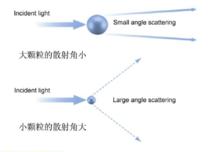意義
目前為止,顆粒樣品最重要的物理特性就是顆粒粒度。 粒度分布測量通常用於在多個行業,粒度常常是許多產品製造過程中的關鍵參數。 粒度分布對材料性能有著直接的影響,例如:
•反應速率或溶解速率, 如催化劑、片劑
•懸浮液的穩定性, 如沉積物、塗料
•給藥功效,如哮喘吸入器
•質地與感覺,如食品添加劑
•外觀,如粉末塗料及油墨
•流動性與操作性,如顆粒
•粘度,如鼻噴噴霧
•堆積密度與孔隙率,如陶瓷
測量顆粒粒度並了解其對產品與工藝的影響是許多製造業成功的關鍵。
分類
Static Laser (靜態雷射散射)
Spectrum is stable space distribution, Mainly for testing micron-sized particles, improved measurement limit may also be extended to tens of nanometers.
Dynmic Laser(動態雷射散射)
1.Static Laser (靜態雷射散射)
Spectrum is stable space distribution, Mainly for testing micron-sized particles, improved measurement limit may also be extended to tens of nanometers.
2.Dynmic Laser(動態雷射散射)
According to Brownian motion speed of particles,Analyzing nanometer particle size by detecting dynamic light scattering signal of one or two angles, and the spectrum is changing at high speed over time, Particle size analyzer with dynamic light scattering principle are only for testing nanoscale particles.
3. Laser Particle Size Analyzer Principle(粒度儀的原理)
Laser particle size analyzerisbased onphysical phenomenonof Particles make laser scattering, Since the laser has good color and is highly directional, so a bunch of parallel laser will be irradiated to infinity placein the absence of obstruction of infinite space, and in the communication process there is little divergence phenomenon.
When the beampass through the particles,the light scattering phenomenon will occur.
As photo shows, The propagation direction of the scattered light will form an angle with the direction of propagation of the primary beam θ.
 laser scattering angle
laser scattering angleScattering theory and experimental results tell us that the size of the scattering angle θ is referent to the size of the particles, particlesize is larger, the angle θ generated by scattered lightis smaller;the particlesize is smaller, the scattered light angle θisgreater.
 Particle size/scattering angle
Particle size/scattering angleAnd further studies showed that the intensity of the scattered light represents the number of the particle size. Thus, measuring the intensity of scattered light at different angles, you can get the particle size distribution of the sample.
4, Application:(產品套用行業)
cement, ceramics, medicines, lotions, paints, dyes, pigments, fillers, chemicals, catalysts, drilling mud, abrasives, lubricants, coal, sediment, dust, cells, bacteria, food additives, pesticides, explosives, graphite, photographic materials, fuel, ink, metal and non-metal powder, calcium carbonate, kaolin, coal slurry and other powdered materials.
目前雷射類粒度儀產品分類有:
濕法分散樣品的粒度儀
乾法分散樣品的粒度儀
乾濕法一體粒度儀
納米粒度分析儀
1.濕法分散樣品的粒度儀
2.乾法分散樣品的粒度儀
3.乾濕法一體粒度儀
4.納米粒度分析儀
影響因素
一、儀器測試範圍及解析度
同價位下,客戶往往都會選擇儀器測試範圍更寬的廠家,任何事物都具有兩面性,雷射粒度儀測試範圍的提升有多種途徑:加長光路,更換不同波長的雷射器,增加鏡頭或雷射器,頻譜放大等。雷射粒度儀器在提升測試範圍的情況下,其它關鍵指標就會隨著發生變化。
客戶購買雷射粒度儀一般有兩個用途:科研及指導生產,首先選擇的應是測試的穩定性和重現性,準確性是可以通過國家標準物質及其他間接方法標定的,在科研及生產過程中改進工藝,粒度測試結果應隨著發生變化,如果測試不穩定重現性差,則對科研及生產就沒有了指導意義。
因此,在選擇儀器測試範圍時應根據客戶自己的實際需要,廠家所報出的粒度測試範圍都是邊界範圍,所以在與廠家溝通時應說明所測試樣品中位徑及上下限,這樣便於廠家為客戶推薦合適的儀器。
二、儀器操作智慧型化程度
雷射粒度分析儀器與其它測試儀器不同,影響雷射粒度儀測試結果的因素很多,在很多文章中都有分析,提高儀器操作的智慧型化能有效地提高測試結果的穩定性和準確度。
(1)光路對中智慧型化
雷射粒度儀器測試原理就是根據大顆粒散射角度小,小顆粒散射角度大而布置光電探測陣列進行光譜採集的:
對於確定的光路,光電探測陣列每一個通道對應一個特徵粒徑,如果光路對中發生了偏差,散射光到達光電探測陣列的通道數也發生偏移,會對測試結果產生較大的影響。
如果採用人工對中方式,每次對中的結果都是不一樣的,而自動對中則可以保證每次對中結果基本一致。
(2)測試過程智慧型化
分散時間,保存數據時間等,這些都是影響雷射粒度分析儀測試的一些因素,越來越高的智慧型化成為雷射粒度分析儀發展趨勢。
因此在選擇雷射粒度儀的時候應優先選擇帶一鍵操作功能的雷射粒度分析儀,如果能夠手動、智慧型一體化就更好,這樣不但適用於普通測試,還可以套用於材料的科學研究。
(3)結果輸出智慧型化
雷射粒度分析儀在測試過程中的結果是一個變化的過程,且測試結果數據量較多,一般1秒2條數據,測試30秒就有60條數據,如何科學的處理這樣數據得到最終的粒度測試結果,用戶是無法做到了的,因此要結果輸出智慧型化。
三、關鍵硬體參數
(1)雷射器
He-Ne雷射器:氦氖雷射器是研製成功的第一種氣體雷射器,單色性好。
固體雷射器:用固體雷射材料作為工作物質的雷射器。
半導體雷射器:半導體雷射器又稱雷射二極體,是用半導體材料作為工作物質的雷射器。
現在雷射粒度分析儀上採用的雷射器主要為以上3種,He-Ne雷射器單色性好,但受到雷射功率的影響的限制,He-Ne雷射器主要用在短光路、短量程的雷射粒度儀器中;固體雷射器光斑及功率都較好,但其穩定性差,使用壽命短;半導體雷射器是近年來發展較快,半導體雷射器出光不圓,但可以通過光纖輸出,形成了現在市面上比較受歡迎的光纖半導體雷射器。國內粒度儀廠家也在嘗試使用這種新式雷射器.
(2)通道數
雷射粒度儀探測通道的設定有一定的規則,太多和太少都不合理,通道數太少儀器解析度不行,通道數太多解析度提高儀器重現性變差,因此在對儀器通道數選擇上應和儀器測試範圍相對應。
(3)對中精度
雷射粒度儀器對中精度一般為微米級。
(4)數據採集速度
不同類型的雷射粒度儀對數據採集速度是不同的,對於樣品能夠循環測量的粒度儀,如濕法雷射粒度儀,對數據採集速度要求不高,但對於單次測試的粒度儀,如噴霧及乾法粒度儀對數據採集速度的要求就比較高了,現在市場的雷射粒度分析儀一般為1000次/秒。

